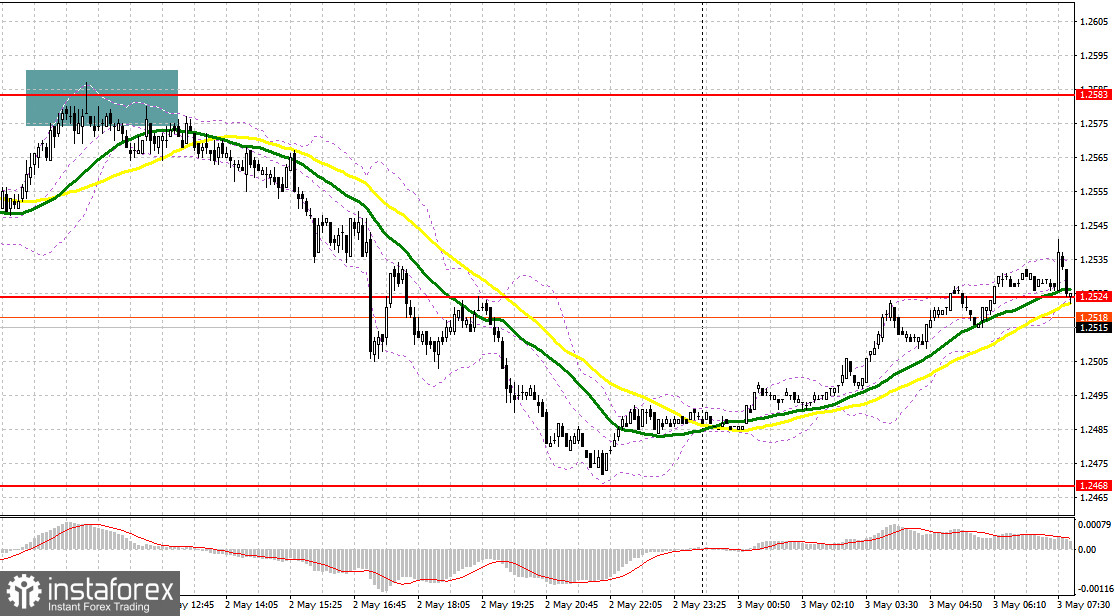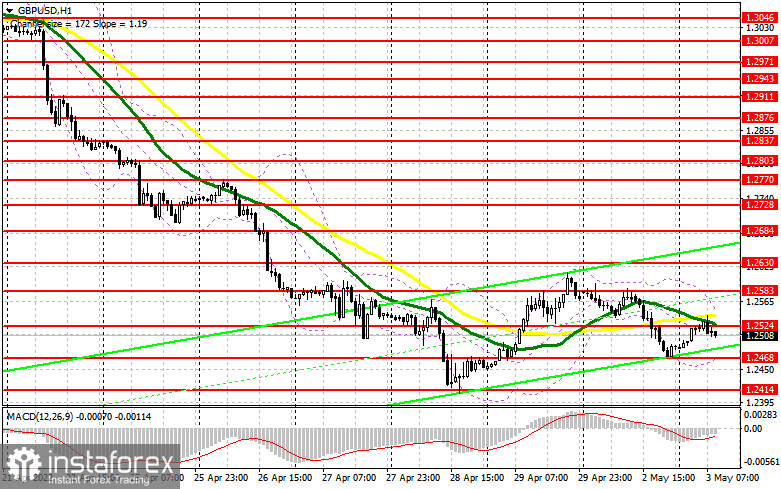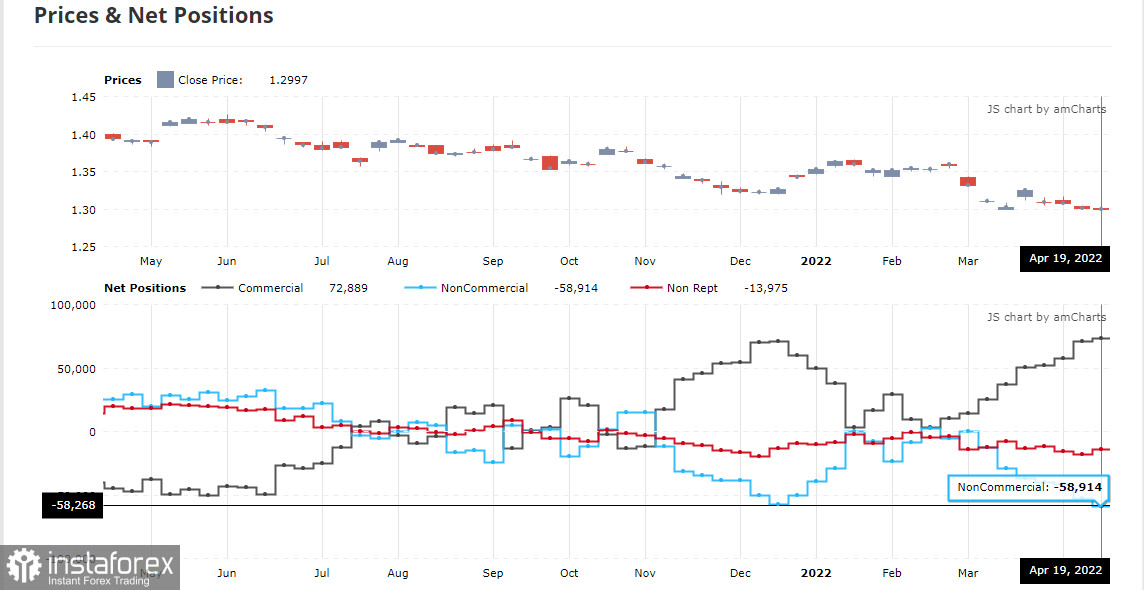Yesterday, only one signal was formed to enter the market. Let's take a look at the 5-minute chart and see what happened. The bulls' failure to rise above 1.2583 resulted in forming a false breakout and created a signal to sell the pound. As a result, the pair went down more than 60 points and almost reached the major support at 1.2468 – just a couple of points left. A breakthrough and consolidation below 1.2524 with a reverse test from below was a good sell signal, but I did not open short positions and take risks at the end of the day.

When to go long on GBP/USD:
The pound bulls still have a chance to continue rising after Friday's attempt to build a good upward correction, but for this it is necessary to be more aggressive. Otherwise, all initiative will be lost. Considering that a rather curious report on manufacturing activity in the UK will be released today, we can expect an upwards surge for the pound. I advise you to bet that the pair could recover to 1.2524 in case we receive a good report. A breakthrough and consolidation above this range with a reverse test will provide an entry point into long positions with the goal of a breakthrough to the 1.2583 area, where I recommend taking profits. It is rather difficult to count on a more active movement towards 1.2630, especially before tomorrow's Federal Reserve meeting. A breakthrough of 1.2630 will open the way to 1.2684. In case the pair goes down, the bulls need to work hard on protecting the 1.2468 level, where the lower border of the upward correctional channel, formed following last week's results, passes. There I recommend waiting for a false breakout to form and only after that should you buy the pound. If the bulls are not active at 1.2468, I advise you not to rush into buying. You can open long positions immediately for a rebound only in the area of 1.2414, and even then, based on an upward correction of 25-30 points within the day.
When to go short on EUR/USD:
The main goal for today is to surpass the nearest support at 1.2468, as regaining control of this level will completely transfer the market under their control. A breakthrough and reverse test of 1.2468 from below creates a sell signal, which will quickly push the GBP/USD to the 1.2414 area, where there will be even fewer bulls. Weak data on the UK and a similar breakthrough of this range will strengthen the bear market, with the prospect of reaching a low like 1.2369, where I recommend taking profits. The 1.2321 level is a more distant target. In case GBP/USD grows, the bears will try to do everything to prevent the exit above the resistance of 1.2524, where the moving averages are, playing on the bears' side. An exit above 1.2524 will strengthen the upward correction and lead to removing a number of stop orders. Forming a false breakout there will be an excellent signal to sell in order to continue the bear market. If there is no activity around 1.2524, the bulls will try to push the pound even higher. Then I advise you to postpone short positions until the next major resistance at 1.2583. I also advise you to open short positions there only in case of a false breakout. You can sell GBP/USD immediately for a rebound from the high of 1.2630, counting on the pair's rebound down by 30-35 points within the day.

COT report:
The Commitment of Traders (COT) report for April 19 showed that both short and long positions have increased, but there were much more of the former, which is obvious if you look at the GBP/USD chart. The UK economy is in very bad shape, as Bank of England Governor Andrew Bailey confirmed last week. His statements that the economy is heading into recession were the last straw holding back pound bears in the second half of April. As a result, surpassing the annual low and a new major sell-off of the pound has already driven the trading instrument below the 26th figure, and it seems that this is not the end. The consumer price index is climbing steadily into double digits, and a worsening global situation due to disruptions to supply chains amid a new wave of Covid-19 in China creates even more problems. The situation will only get worse, as future inflationary risks are now quite difficult to assess also due to the difficult geopolitical situation, but it is clear that the consumer price index will continue to rise in the coming months. The situation in the UK labor market, where employers are forced to fight for each employee, offering ever higher wages, is also pushing inflation higher and higher. The pressure on the pound is also growing for another reason - the aggressive policy of the Federal Reserve. The Committee may announce an increase in interest rates immediately by 0.75% during the May meeting - they do not have such problems as in the UK with the economy yet. The April 19 COT report indicated that long non-commercial positions rose from 35,514 to 36,811, while short non-commercial positions jumped from 88,568 to 95,727. This led to an increase in the negative value of the non-commercial net position from - 53,054 to -58,268. The weekly closing price fell from 1.3022 to 1.2997.

Indicator signals:
Trading is conducted in the area of 30 and 50-day moving averages, which indicates an attempt to turn the market.
Moving averages
Note: The period and prices of moving averages are considered by the author on the H1 hourly chart and differs from the general definition of the classic daily moving averages on the daily D1 chart.
Bollinger Bands
In case of growth, the upper border of the indicator around 1.2524 will act as resistance. In case of a decline, the lower border of the indicator around 1.2468 will act as support.
Description of indicators
- Moving average (moving average, determines the current trend by smoothing out volatility and noise). Period 50. It is marked in yellow on the chart.
- Moving average (moving average, determines the current trend by smoothing out volatility and noise). Period 30. It is marked in green on the chart.
- MACD indicator (Moving Average Convergence/Divergence — convergence/divergence of moving averages) Quick EMA period 12. Slow EMA period to 26. SMA period 9
- Bollinger Bands (Bollinger Bands). Period 20
- Non-commercial speculative traders, such as individual traders, hedge funds, and large institutions that use the futures market for speculative purposes and meet certain requirements.
- Long non-commercial positions represent the total long open position of non-commercial traders.
- Short non-commercial positions represent the total short open position of non-commercial traders.
- Total non-commercial net position is the difference between short and long positions of non-commercial traders.





















